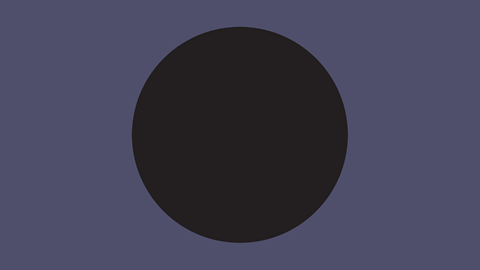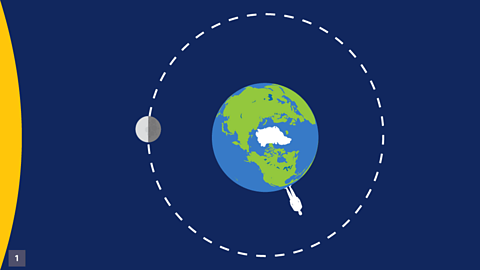Key Terms
The Moon does not produce its own light. We can see the Moon because it reflects light from the Sun.
The Moon orbits the Earth, and as this happens the MoonÔÇÖs appearance when viewed from the Earth changes because different parts of the Moon are illuminated at different times. This means we see the MoonÔÇÖs phases from Earth as different shapes.
Phases of the Moon
The MoonÔÇÖs appearance changes over time when viewed from Earth. Sometimes, the Moon is not easily seen in the sky and at other times it can appear as a thin crescent moonLess than half of the illuminated part of the moon is visible., a full circle ÔÇô or somewhere in between.
A Moon phase is the shape of the visible part of the Moon, and this changes gradually over the course of a lunar monthThe time between a new moon and the next new moon ÔÇô approximately 29┬Ż days..
A lunar month

Image caption, New Moon
New Moon ÔÇô the illuminated part is not visible at all.
Image caption, Waxing crescent Moon
Waxing crescent Moon ÔÇô less than half of the visible surface is illuminated (starts as a thin, curved sliver) and getting larger.
Image caption, First quarter Moon
First quarter Moon ÔÇô half of the visible surface is illuminated.
Image caption, Waxing gibbous Moon
Waxing gibbous Moon ÔÇô more than half of the visible surface is illuminated - and getting larger.
Image caption, Full Moon
Full Moon ÔÇô the entire visible surface is illuminated.
Image caption, Waning gibbous Moon
Waning gibbous Moon ÔÇô more than half of the visible surface is illuminated - and getting smaller.
Image caption, Third quarter Moon
Third quarter Moon ÔÇô half of the visible surface is illuminated.
Image caption, Waning crescent Moon
Waning crescent Moon ÔÇô less than half of the visible surface is illuminated ÔÇô and getting smaller.
1 of 8
A lunar monthThe time between a new moon and the next new moon ÔÇô approximately 29┬Ż days. lasts around 29.5 days and starts with a new moonThe illuminated part of the moon is not visible at all. ÔÇô when the Moon is not easily seen in the sky because the light from the Sun lands on the side of the Moon which is facing away from Earth.
As the Moon moves around Earth, the illuminated section of the MoonÔÇÖs surface starts to face towards the Earth, and we see a thin crescent moonLess than half of the illuminated part of the moon is visible. appear.
Over the course of a lunar month, the Moon goes through the following phases:

Did you know?
Earth's only natural satellite is simply called ÔÇśthe MoonÔÇÖ because people didn't know that other moons existed until 1610 when Galileo discovered the four largest moons orbiting Jupiter: Io, Europa, Ganymede, and Callisto.
What causes lunar phases?
The Moon is non-luminous, meaning that it does not produce light. We see the Moon because it reflects light from the Sun, and half of the MoonÔÇÖs surface is always illuminated. The amount of this illuminated portion that we can see from Earth varies, depending on the angle that we are viewing from. This changes as the Moon orbits Earth, and Earth orbits around the Sun.

Image caption, When the moon is between Earth and the Sun, the illuminated part of the Moon is facing away from Earth so we cannot see it at all ÔÇô this is a new Moon.
Image caption, As the Moon moves around Earth, we begin to see some of the illuminated part of the Moon ÔÇô this is a crescent Moon. As the Moon continues around its orbit the crescent grows in size, known as waxing, as more of the illuminated part of the Moon becomes visible.
Image caption, When the Moon is one quarter of the way around its orbit, we see half of the visible surface of the Moon illuminated ÔÇô a first quarter Moon.
Image caption, As the Moon continues around its orbit, we see more of the illuminated part of the Moon. More than half of the MoonÔÇÖs visible surface is illuminated ÔÇô this is a gibbous moon.
Image caption, When the Moon is on the opposite side of Earth to the Sun, the illuminated part of the Moon is facing towards Earth ÔÇô so we see a full Moon. This occurs when the Moon is halfway around its orbit, approximately two weeks after the start of the lunar month.
Image caption, As the Moon continues to move around its orbit, less of the illuminated part of the Moon is visible ÔÇô this is a waxing gibbous Moon.
Image caption, When the Moon is three quarters of the way around its orbit, we see half of the visible surface of the Moon illuminated again ÔÇô a third quarter Moon.
Image caption, As the Moon continues through its orbit it continues the size of the illuminated part of the Moon which is visible continues to decrease. Less than half of the illuminated part of the Moon is now visible ÔÇô a waning crescent Moon. The lunar cycle starts again with a new Moon, when the Moon has returned to its original position, between the Sun and Earth.
1 of 8
Test your knowledge
Play the Atomic Labs game! gamePlay the Atomic Labs game!
Try out practical experiments in this KS3 science game.

More on Space
Find out more by working through a topic
- count5 of 9

- count6 of 9

- count8 of 9
